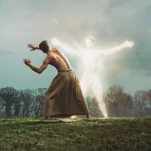Isle of Dogs

Isle of Dogs may be the closest Wes Anderson will ever get to a sci-fi film. Of course he would use stop-motion animation to make it. Set 20 years from now, amidst the ultra-urban monoliths of Megasaki City—a Japanese metropolis that also seems to be Japan, or at least a Westernized idea of the small island nation—the film begins care of a decree by Mayor Kobayashi (Kunichi Nomura), a boulder of a man with equal ties to an ancient lineage of cat-loving aristocrats and to, based on the elaborate back tattoo we glimpse atop his tight little butt in a quick bath scene, an archetype of organized crime and political corruption. (The film actually begins on a prologue, a tapestry maintained by an old man with a long beard describing the prelapsarian feud between dog people and cat people.) Due to a vaguely described epidemic of “dog flu” (or “snout fever”), Kobayashi bans all dogs to Trash Island, a massive byproduct of technology and futurism, beginning with Spots (Liev Schreiber), the guard dog of 12-year-old Atari (Koyu Rankin), who also happens to be the Mayor’s ward after Atari’s parents died in a horrible accident.
Since Bottle Rocket in 1996, the more manicured Anderson’s films have become—his obsessive control over his frames broadening into grander and grander worlds—the more we may be apt to extol his accomplishments rather than get invested in his stories. And it’s probably never been easier to do that than with Isle of Dogs, so rife with meticulousness and imagination, as is Anderson’s brand, and so unconcerned with steering this ostensible children’s movie towards actual children. For a director who pretty much defined a generation’s cinematic fetishization for symmetry (and quirky hipster nonsense) to then fetishize a country to which Westerners mainly relate through fetishization? So much of this beautiful movie just sort of eats itself.
Anderson’s cast comprises mostly A-list, white actors, everyone he knows able to get on his wavelength and deliver the precise tone he’s striking. As Max Landis has deigned to teach us braying, dull-eyed consumers, this is how you get a movie as painstaking and expensive and time-consuming as Isle of Dogs made. Dumping Spots to fend for himself on Trash Island (heartbreakingly left in his locked cage), Kobayashi orders the rest of the dogs in Megasaki rounded up and moved out, pets ripped from their families by his militaristic force of dog-catchers, spurred on by their Mayor’s authoritarian propaganda. Missing his dog too much, Atari hijacks a small plane and flies to Trash Island, where he crashes into the territory of a rigorously democratic pack of alphas—five of them: Rex (Edward Norton), King (Bob Balaban), Duke (Jeff Goldblum), Boss (Bill Murray) and lifelong stray, resolutely against all masters, Chief (Bryan Cranston). The film can often get bleak, but Norton provides a guiding, capable presence, while Balaban and Murray add warmth to an especially cold setting. To be expected, really, because Anderson knows exactly how to use these guys by now, but what feels like such a step forward for him as a storyteller is the comfort these achingly realized characters can give his viewers. The future Japan he’s imagined can be a grim place; we depend on these animals to lead us through.
The emotional weight of Isle of Dogs depends on knowing exactly what that bond between dog and human can mean, how deeply and irrationally it can go. The purest scene in the film occurs early, in which Atari, still recuperating and bedridden after his family’s recent death, meets Spots, his new dog. Staring unblinkingly into each other’s eyes, both beginning to cry, Spots knows he’ll protect the vulnerable Atari, and Atari knows he’ll protect the vulnerable Spots—because Spots is a dog, and all dogs are vulnerable. At the core of Isle of Dogs is that kind of best-friendship: No matter how far we advance as a civilization, how disastrously we atomize and digitalize our lives, we’ll always have the devoted dependence of a dog, our immutable companion across the vast wasteland of human history. As much as the movie is an enrapturing, sometimes overwhelming experience, filled with passion and hard work and adoration for the impossible task of making such a singular movie at all, Anderson and his animation team find the film’s soul in these dog’s eyes. Such a brilliant touch to have the dogs cry, to give us a simple connection to these creatures when their faces may not be meant for emoting.
-

-

-

-

-

-

-

-

-

-

-

-

-

-

-

-

-

-

-

-

-

-

-

-

-

-

-

-

-

-

-

-

-

-

-

-

-

-

-

-








































